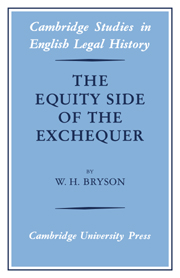Book contents
- Frontmatter
- Contents
- Preface
- Principal abbreviations
- Table of statutes cited
- 1 Introduction
- 2 The equity jurisdiction of the exchequer
- 3 The administration of the court
- 4 Procedures and records
- 5 The suppression of the jurisdiction
- Appendix 1 Chart showing the quantity of bills filed
- Appendix 2 Lists of officers
- Bibliography
- Index
4 - Procedures and records
Published online by Cambridge University Press: 07 October 2011
- Frontmatter
- Contents
- Preface
- Principal abbreviations
- Table of statutes cited
- 1 Introduction
- 2 The equity jurisdiction of the exchequer
- 3 The administration of the court
- 4 Procedures and records
- 5 The suppression of the jurisdiction
- Appendix 1 Chart showing the quantity of bills filed
- Appendix 2 Lists of officers
- Bibliography
- Index
Summary
PLEADINGS
Bills of complaint
The equity bill of complaint was in the nature of a petition. It was a request addressed to the judge to hear the case and to do justice to the disputants. In the old common law courts of the common pleas and the king's bench, a lawsuit was normally initiated by the command of the king which was embodied in an original writ made out in chancery; this command ordered the sheriff to have the party against whom it was directed to appear in court where the common law judges were required to hear and decide the case. Since writs did not lie against the monarch, the only way for redress from the crown was by means of a bill of right or a petition of right exhibited in the chancery. These bills were to protect common law rights (though writs were more often used) and were in Latin; they were put in chancery because the chancellor administered the judicial aspects of the royal prerogative. These proceedings were on the common law side, the Latin side, of the court of chancery. When the equity side of the chancery arose in the fifteenth century, the pleading was done in the vernacular, which was by the end of that century English. Thus bills exhibited on the equity side of the chancery were known as English bills in contradistinction to the older Latin bills.
- Type
- Chapter
- Information
- The Equity Side of the Exchequer , pp. 93 - 159Publisher: Cambridge University PressPrint publication year: 1975



